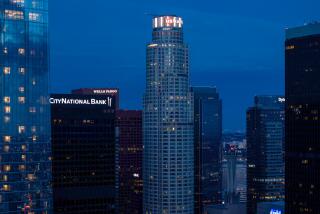From the Archives: City National’s ‘banker to the stars’
- Share via
He’s the ultimate insider at the ultimate insider’s bank, the place Frank Sinatra turned to for ransom money when his son Frank Jr. was kidnapped. Michael Jackson partied in his vault.
Bram Goldsmith, 89, has seen it all at City National Bank. The son-in-law of one of the founders, he took the reins of the “bank to the stars” in the mid-1970s and remains chairman of the parent company to this day.
____
For The Record
This article misidentified the bank’s first chairman as Ben Maltz, the grandfather of City National Chief Executive Russell Goldsmith. The bank’s first chairman was Jay Kasler.
___
Launched in 1954, City National’s 58-year run stands out in an industry where small banks tend to get gobbled by larger rivals. Rather than sell out, the Goldsmiths built the Beverly Hills community bank into a backer of growth companies across California and a national force in entertainment.
The institution boasts 78 branches in five states and $21 billion in deposits, the most of any bank based in Southern California. It has reported a profit every quarter for the last 191/2 years.
“We’ve seen soft spots in the economy, but we’ve been conservative, careful about not getting trapped in a bad situation,” Goldsmith says. “We find that if we keep our nose clean and our gunpowder dry we do OK.”
Clients include Coffee Bean & Tea Leaf, the Los Angeles Galaxy, broadcast legend Vin Scully and celebrity chef Wolfgang Puck. City National bankrolls Hollywood producers, country-western pickers in Nashville and hip-hop artists in Atlanta. It directly manages more than $32 billion in investments for wealthy individuals and institutions.
Looking back at the bank’s history, Goldsmith shares anecdotes that erase the years.
There’s the oft-told tale of how his predecessor as bank chairman, Alfred S. Hart, produced $240,000 in cash on short notice in 1963 to ransom Frank Sinatra Jr., abducted from Harrah’s Lake Tahoe.
Sinatra repaid that and other favors from Hart in 1975 by performing at a benefit that raised $3.5 million from hundreds of Hollywood A-listers to help build the Alfred and Viola Hart Tower at Cedars-Sinai Medical Center.
Goldsmith, of course, was there. He remembers the crooner thanking Al Hart at the event: “I owe him and City National Bank everything, and that’s why I’m here, to say thank you very much.”
With such an endorsement, little wonder that more than a quarter of City National’s loans are still made to the entertainment industry. The bank helps finance about 50 films a year and, by its count, is providing banking services to 14 of the 28 current shows on Broadway, including the smashes “Once” and “The Book of Mormon.”
One of the biggest factors in the bank’s success is its kid-gloves service to modern Hollywood’s behind-the-scenes power structure: the managers, lawyers and accountants who handle business and investments for actors, directors, musicians, athletes.
When a producer wanted a stack of yen delivered to the airport or the Jackson 5’s manager needed a party venue, City National was proud to oblige.
“That’s why we’ve grown so much,” Goldsmith says. “We’ve always done a good job for them.”
The Goldsmiths rank among Southern California’s philanthropic as well as business elite. The names of Bram and wife Elaine Goldsmith are on the walls of art colleges and performing arts centers, hospital research centers and endowed chairs at the L.A. Philharmonic.
And the bank has thrived.
Although stung by losses on construction loans and commercial mortgages during the recent recession, City National avoided the subprime home loan and trading debacles that flattened larger rivals. In a burst of acquisitions, branch openings and new lending since 2008, assets have increased 50%, with profit growing from $51 million in 2009 to $172 million in 2011 and trending higher this year.
The stock is still down 27% from five years ago. But that beats a 33% decline in a national index of regional bank stocks, and investors so far seem content to let the family-controlled bank (the Goldsmiths’ stake is nearly 15%) determine its own course.
“These guys were in a position of strength coming out of the downturn,” says RBC Capital Markets analyst Joe Morford, who has followed City National for 20 years. “So they are in a position to gain market share.”
For the last 17 years, the main hand on the tiller has been that of Russell Goldsmith, Bram’s 62-year-old son, who is chairman and chief executive of the bank and CEO of parent City National Corp.
Russell Goldsmith, a former entertainment executive with Harvard undergraduate and law degrees, offers polished guest commentaries on CNBC and explains to a visitor how his clientele includes the 5% as well as the 1%.
“If you go to our branch downstairs and you have $500,000 instead of $200 million we have a product set there [for you],” he says. “That’s part of what we’ve done -- try to help clients of every level have the ability to build their wealth with City National.”
City National’s founders started as outsiders who clawed out fortunes in various down-to-earth enterprises during the rough-and-tumble of Los Angeles’ noir period.
Many joined the Hillcrest Country Club in Beverly Hills, a retreat for stars and their representatives who as Jews were unwelcome at downtown’s Jonathan and California clubs, bastions of what passed for old money in boomtown L.A.
These entrepreneurs had been snubbed by old-line bankers with little interest in funding new ventures, Bram Goldsmith says. “Starting a new business, if you were having a problem, they wouldn’t think about helping you.”
So Hart and his circle opened the bank in 1954 with a focus on helping to grow young businesses -- the philosophy still reflected in the bank’s motto, “The way up.”
“If they’re entitled to a loan the officers should lend them money, and if they’re not entitled they shouldn’t lend them money,” Bram Goldsmith says. “But you treat them as good customers. And we have always done precisely that -- give people the courtesy of respecting them.”
The bank’s first chairman was Bram’s father-in-law and Russell’s grandfather, Ben Maltz, a whiskey broker from Chicago who was partners in a wholesale liquor business with Hart.
Hart, who became the bank’s president in 1955, was, as Mercury Savings & Loan Chairman Leonard Shane told The Times in 1985, both brilliant and uncouth, “a rough, tough cookie” who wound up among the founders of the Los Angeles County Museum of Art and the Music Center.
In his 2006 book, “Supermob: How Sidney Korshak and His Criminal Associates Became America’s Hidden Power Brokers,” Gus Russo wrote that Hart’s past included a stint as a beer driver for Al Capone, eight arrests related to illegal games of chance at a cigar store he ran in downtown L.A., and a stake in the Benjamin “Bugsy” Siegel partnership that built the Flamingo Hotel & Casino in Las Vegas.
But it was Hart’s connections to Hollywood and the celebrity world that proved instrumental in shaping City National’s identity. He was a director of Columbia Pictures for 20 years and president of the Del Mar racetrack in 1953, when MGM boss Louis B. Mayer was its chairman.
Hart had carried his good friend Sinatra through some lean years in the early 1950s and helped resurrect his career by helping to finance the film “From Here to Eternity.”
Another Hart pal was Korshak, a powerful labor lawyer identified in congressional testimony as the liaison between Hollywood and the Chicago mob. Korshak and Sinatra directed their associates to the ultra-private new bank, assuring them that their funds would avoid outside scrutiny, Russo wrote.
“It was like a Swiss bank account in Beverly Hills,” he said in an interview.
Bram Goldsmith, who replaced his father-in-law on City National’s board in 1964, says he knew of no Hart ties to underworld figures. He recalls Hart as “a very generous human being,” for his philanthropy and support of his many friends.
Besides entertainment, City National’s other strong suit was always real estate, a field Goldsmith knows something about.
He was an up-and-coming young builder from Chicago when he followed his father-in-law west in the winter of 1952, with Russell barely out of diapers. His mother-in-law rented a house for the family for a month on Rodeo Drive north of Wilshire Boulevard, which at the time had a bridle path beside the street.
“We left Chicago with 8 inches of snow, and it took days to dig out the driveway to get the car and ship it here. I looked out the window and here were two people cantering along!” he recalled.
“I said, ‘My God, this is heaven! Forget going anywhere else.’”
The founders had raised $3 million in capital when City National opened in January 1954, “a hell of a lot of money in those days,” Goldsmith recalled, and the start-up boomed.
A 1958 Times story said assets reached the “astonishing total” of $42.5 million in just four years, which “shattered all national banking records.” (City National had $24 billion in assets as of June 30.)
Meanwhile, Bram Goldsmith was carving out his career at Buckeye Construction Co., making millions with City National backing as he graduated from suburban homes to office buildings over the years -- 31 of them in Beverly Hills, where they still line Wilshire Boulevard.
A 1965 Times photo shows Hart with Goldsmith, watching steelworkers place a 32-ton caisson in the ground to support L.A.’s newest skyscraper. It was City National’s 26-story tower at Pershing Square, at the time one of the tallest buildings downtown and a joint venture between the bank and Buckeye, which Goldsmith ran along with partner George Konheim.
(The bank’s current headquarters, City National Plaza downtown, was built in a joint venture by onetime California giants Richfield Oil Co. and Bank of America, now merged into out-of-state conglomerates. “In a sense, we have replaced Arco and Bank of America,” Russell Goldsmith says. “It’s remarkable.”)
After buying out Hart and becoming chairman and CEO in 1975, Bram Goldsmith enjoyed notable success in banking as well. He pegged his compensation to the bank’s stock price, and the rapidly expanding City National so outperformed its rivals that Goldsmith earned $3.1 million in 1984 when the bill came due.
It made him the nation’s highest-paid bank executive that year, earning more than the CEOs of the top three banks -- Bank of America, Citibank and Chase Manhattan -- combined.
The tradition of growth and reward continues. Russell Goldsmith’s $9.5-million compensation package last year was second highest among the 42 CEOs of publicly traded banks with $10 billion to $50 billion in assets, according to research firm SNL Financial. Only Dominic Ng at East West Bancorp in Pasadena, at $10.7 million, earned more in this category of smaller regional banks.
Regrets? They’ve had a few, mostly for passing on deals that proved home runs for others, such as IndyMac Bank, the big Pasadena home lender that failed in 2008. IndyMac was purchased from the government by a hedge fund consortium and has turned impressive profits in its new incarnation as OneWest Bank.
“Had we bid on IndyMac we would have been betting the franchise,” Russell says. “It would have worked out great in hindsight. But taking that much risk would have completely distorted what our bank was about and who we are.”
Oh, well. Just another story from front-row seats at life in the big leagues, L.A.-style.
--
scott.reckard@latimes.com
More to Read
Inside the business of entertainment
The Wide Shot brings you news, analysis and insights on everything from streaming wars to production — and what it all means for the future.
You may occasionally receive promotional content from the Los Angeles Times.









